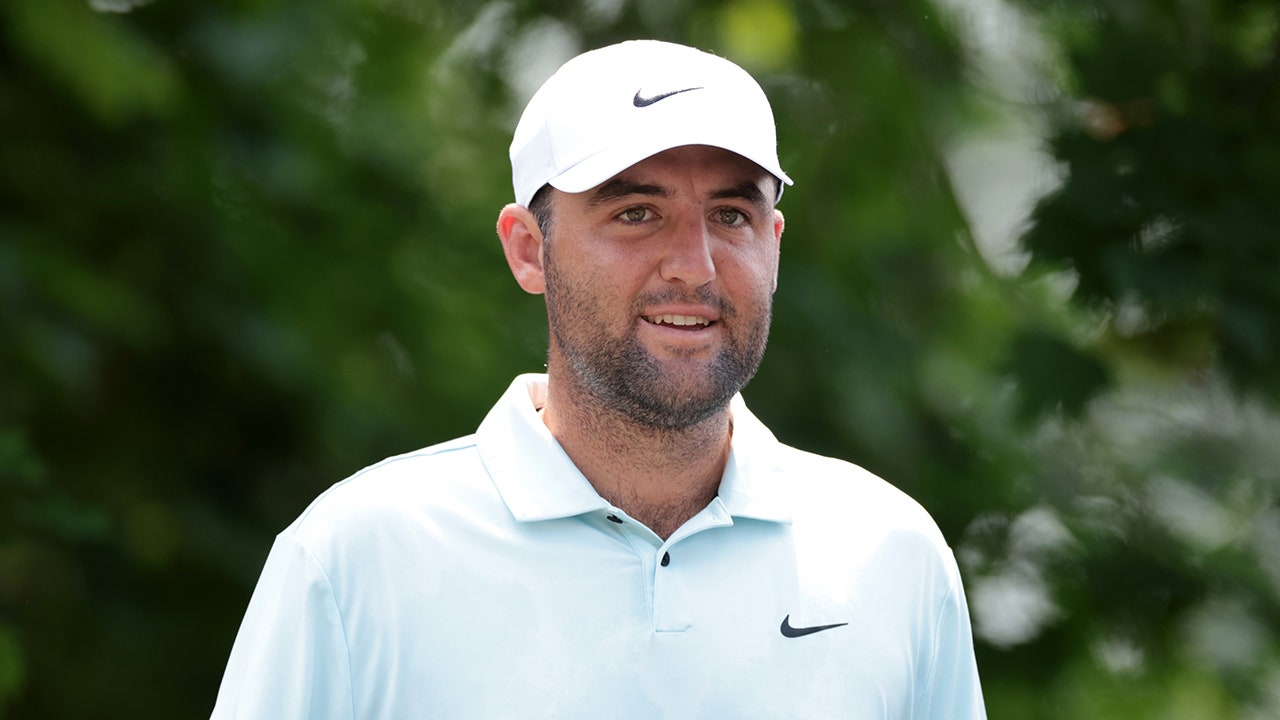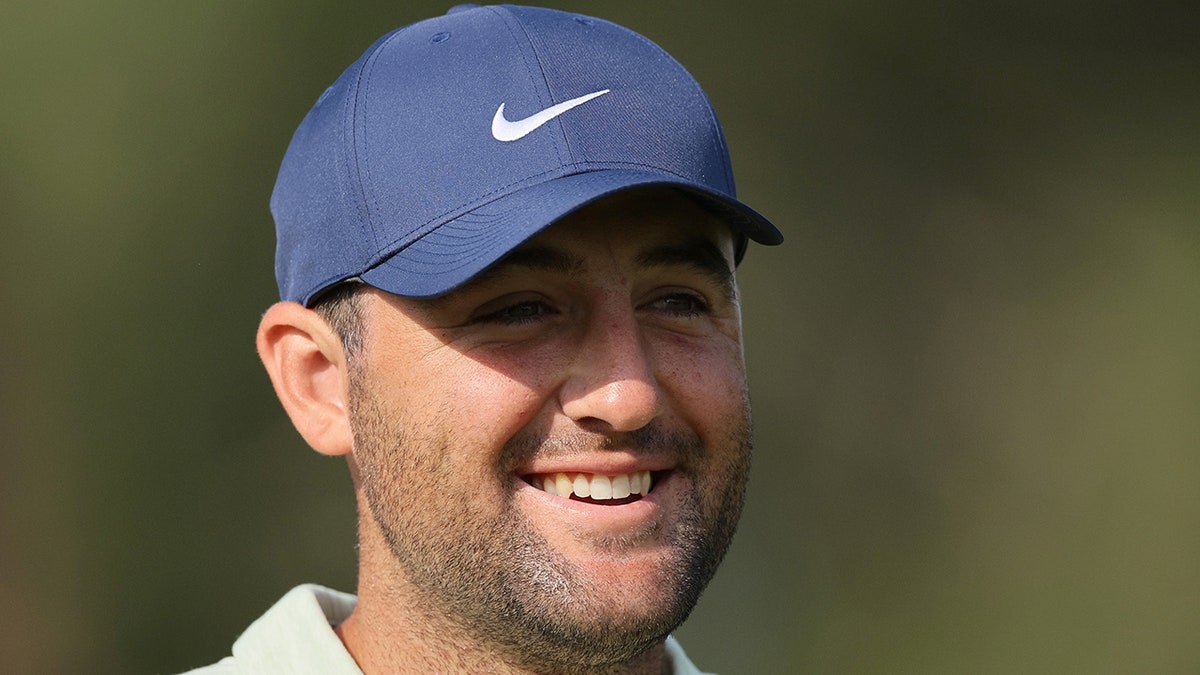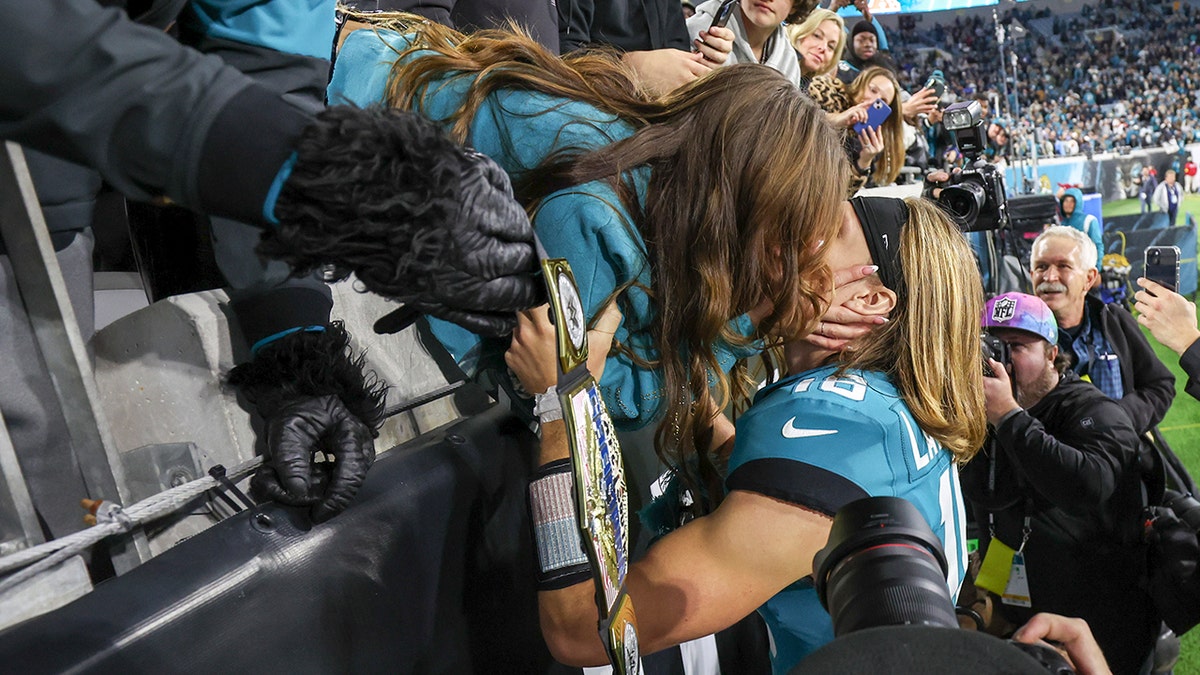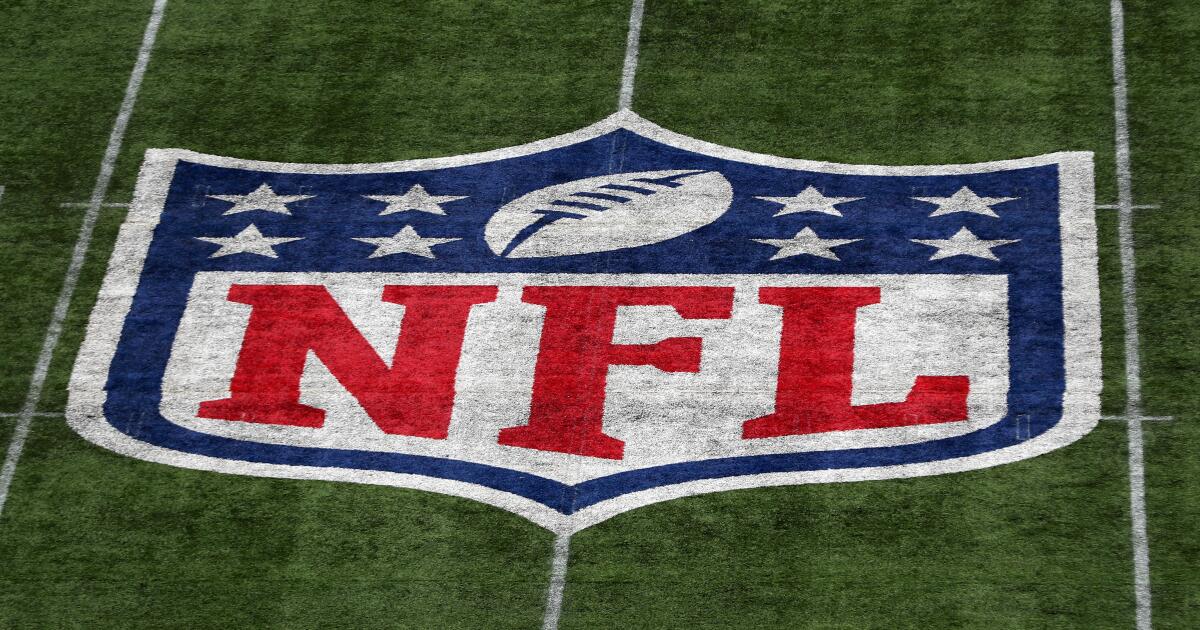Sports
Scottie Scheffler shares sweet surprise with PGA Tour fans waiting over an hour to meet him

A group of PGA Tour fans who waited over an hour after the second round at the Travelers Championship got a sweet surprise when Scottie Scheffler walked out of the clubhouse.
It was Scheffler’s birthday on Friday, as the world’s No. 1 golfer turned 28 years old.
“Happy birthday, Scheff!” one fan yelled out to Scheffler in a PGA Tour video posted to social media.
Scottie Scheffler of the United States lines up a putt on the ninth green during the first round of the Travelers Championship at TPC River Highlands on June 20, 2024, in Cromwell, Connecticut. (James Gilbert/Getty Images)
“Thank you,” he quickly replied.
Scheffler, who recently became a dad, was pushing his son, Bennett, in a stroller. But he was only using his right hand, as the left was occupied with a gift he wanted to give the fans after they had waited so long for him outside the grounds.
Scheffler wanted to share his birthday cake with them.
“You guys can have it,” Scheffler said after a fan asked how his cake was, as he walked over holding it in his left hand while pushing a stroller with his son, Bennett, with his right. “We’re not going to eat it. I had a piece inside. They gave me a whole cake.
“Y’all take the cake, seriously.”
The fans were in awe, as they were pulling out items for Scheffler to sign, including a Domino’s pizza box.

Scottie Scheffler during the Pro-Am prior to the Travelers Championship at TPC River Highlands on June 19, 2024, in Cromwell, Connecticut. (Andy Lyons/Getty Images)
“Thank you so much, Scottie!” fans replied, as one took the cake to hold while Scheffler dished out signatures.
Scheffler even signed the cake box when the fan holding it asked.
“We got Scottie Scheffler to give us his birthday cake, and we got the pizza box signed,” the fans said as the video ends with their elation.
Scheffler is a man of the people, and he heads into the weekend in Cromwell, Connecticut, very much in the running for another possible win on Tour this season.
Scheffler shot 6-under yesterday at TPC River Highlands to move into a three-way tie for second place at 11-under for the tournament with Akshay Bhatia and Collin Morikawa.

Scottie Scheffler of the United States walks from the ninth hole during the first round of the Travelers Championship at TPC River Highlands on June 20, 2024, in Cromwell, Connecticut. (James Gilbert/Getty Images)
Xander Schauffele, the 2024 PGA Championship victor, is 10-under in fifth place, while South Korean Tom Kim owns the outright lead with a 13-under score after an impressive 8-under on Thursday and a 5-under Friday round.
Follow Fox News Digital’s sports coverage on X, and subscribe to the Fox News Sports Huddle newsletter.

Sports
Trevor Lawrence, wife announce they are expecting first child after $275 million contract extension

It’s been a fun few weeks for Trevor Lawrence.
Earlier this month, he inked a $275 million deal, making him tied with Joe Burrow for the second-highest paid player in NFL history.
Well, he and his wife, Marissa, announced on Instagram that they are expecting their first child.
Trevor Lawrence is shown with wife Marissa last year. (James Gilbert/Getty Images)
“A little Lawrence on the way,” the couple wrote in a joint post.
In the post, the couple shared 10 photos of a sonogram and of Marissa showing off her baby bump.
Lawrence’s deal includes $142 million guaranteed. He became the sixth QB making more than $50 million a year, joining Burrow, Jared Goff, Justin Herbert, Lamar Jackson and Jalen Hurts. Lawrence is the 14th to top $40 million annually, and he’s the youngest on the list.

Trevor Lawrence of the Jacksonville Jaguars kisses his wife, Marissa, after his team’s playoff-clinching win against the Tennessee Titans at then-TIAA Bank Field in Jacksonville, Florida, on Jan. 7, 2023. (Mike Carlson/Getty Images)
12 SETS OF RECENT BROTHERS PART OF THE NFL: THE KELCES, BOSAS AND MORE
Lawrence has already added his name to the Jacksonville Jaguars’ history books. He is fourth on the franchise’s all-time passing yards list. His 58 career touchdown passes rank fourth in franchise history.
Lawrence finished the past two NFL seasons with more than 4,000 passing yards; he and the Jags won the AFC South in 2022 and were in terrific shape to repeat, but a second half collapse saw them miss the playoffs.
Last season, he threw for 4,016 yards with 21 touchdowns and 14 interceptions. He also ran for four scores, lost seven fumbles and was sacked a career-high 35 times.

Jacksonville Jaguars quarterback Trevor Lawrence runs with the ball during the game against the Baltimore Ravens at EverBank Stadium in Jacksonville, Florida, on Dec. 17, 2023. (David Rosenblum/Icon Sportswire via Getty Images)
The 24-year-old is 21-31 as a starter in three seasons, including 1-1 in the playoffs, and he has a whopping 60 turnovers in three seasons, which is a number he needs to trim to become the player the Jags believe he can be.
Fox News’ Chantz Martin contributed to this report.
Follow Fox News Digital’s sports coverage on X and subscribe to the Fox News Sports Huddle newsletter.
Sports
NFL ordered to pay billions in damages for 'overcharged' Sunday Ticket

The NFL suffered a huge setback Thursday and was ordered to pay nearly $4.8 billion in damages for violating antitrust law in a class-action suit over pricing of DirecTV’s “Sunday Ticket” packages.
A Los Angeles jury voted unanimously that the league colluded with DirecTV, along with CBS and Fox, to drive up pricing of the premium product.
The jury deliberated for roughly five hours over two days. If the verdict stands, the jury said the league owes $4.7 billion in damages to the residential class and $96 million in damages to the commercial class.
The NFL could be liable up to $12.3 billion under federal laws that triple the amount won in antitrust cases.
Said a spokesman for the NFL: “We are disappointed with the jury’s verdict today in the NFL Sunday Ticket class action lawsuit. We continue to believe that our media distribution strategy, which features all NFL games broadcast on free over-the-air television in the markets of the participating teams and national distribution of our most popular games, supplemented by many additional choices including RedZone, Sunday Ticket and NFL+, is by far the most fan friendly distribution model in all of sports and entertainment. We will certainly contest this decision as we believe that the class action claims in this case are baseless and without merit. We thank the jury for their time and service and for the guidance and oversight from Judge Gutierrez throughout the trial.”
The lawsuit covered 2.4 million residential subscribers and 48,000 businesses who paid for the package of out-of-market games from the 2011 through 2022 seasons on DirecTV.
The trial lasted three weeks and included testimony from NFL commissioner Roger Goodell and Dallas Cowboys owner Jerry Jones, among others.
Said Bill Carmody, lead attorney for the plaintiff: “It’s a great verdict for consumers around America that this jury, despite the star power of the defendants, upheld the antitrust laws which are geared to protect consumers from overcharges.
“Justice was served.”
The next likely steps for the dispute will be the filing of post-trial motions, which will be heard by the trial judge on July 31.
If the verdict is not set aside, the judge is likely to be asked to consider possible structural changes in the Sunday Ticket package, as well as plaintiff’s lawyers request for an award of legal fees.
Once those issues are resolved, the league will appeal any adverse rulings to the Ninth Circuit. The NFL expects the payment of any damages and imposition of any structural changes to the Sunday Ticket package would be stayed until all appeals have been concluded.
Fans cheer at a bar in Santa Monica while watching NFL games.
(Gina Ferazzi / Los Angeles Times)
The jury began deliberations Wednesday afternoon in the wake of closing arguments from the sides and jury instructions from U.S. District Judge Philip Gutierrez. Jury deliberations continued Thursday.
It took nearly a decade for the case to wind its way through the legal ecosystem, beginning in 2015 when a San Francisco pub called the Mucky Duck filed a complaint about how the NFL handles its out-of-market broadcasts.
The class action was filed on behalf of more than 2.4 million residential subscribers and more than 48,000 restaurants, bars and other commercial establishments that show the games. It centered on the “Sunday Ticket” package — now sold through YouTube TV — which allows subscribers access to the broadcasts of all out-of-market Sunday games that air on CBS and Fox.
They are not special broadcasts but identical to what people are seeing in those various home markets. By the league’s estimate, a mere 3% of fans subscribe to “Sunday Ticket,” which this season costs $449 absent any discounts or promotions.
The plaintiffs alleged the NFL colluded with network partners CBS and Fox, along with DirecTV, to ensure the pricing of “Sunday Ticket” remained high, thereby violating antitrust law.
The plaintiffs were seeking $7 billion in damages for the period between 2011 and 2022, and those are tripled in antitrust cases. That $21 billion is enough to buy an entire four-team division.
The NFL argued that it was not in control of “Sunday Ticket” pricing but DirecTV was, and often gave away the premium product for free to attract subscribers. Attorneys representing the league frequently pointed out the NFL is the only major sports league that provides fans 100% of local games on free, over-the-air TV.
“It’s a valuable, premium product, and the prices were reasonable,” Beth Wilkinson, representing the NFL, said in her opening statement. “Fans don’t have to buy Sunday Ticket… The league wants as many people as possible to watch the free broadcasts.”
Wilkinson said that after promotions and giveaways, the average price of Sunday Ticket during the period in question was $102.70 per season.
Sports
Missing Bats, Part 3: Before the strikeout craze, baseball's 'Galileos' fought to change the game

Missing Bats, a special series this week in The Athletic, explores how baseball’s profound metamorphosis over the last two decades traces back to one simple idea — maximizing strikeouts at all costs — that became an industry-wide obsession. Explore the entire series here.
The San Diego School of Baseball was backed by hitting stars such as Tony Gwynn and Alan Trammell, but it was the pitching minds that gave the early 1980s baseball camp its charm — and its legacy.
Brent Strom and Tom House had been teammates at the University of Southern California and then, later, journeyman pitchers in the major leagues. Aside from lineage, they also shared deep-seated hunches that there was more to learn about baseball than previous generations had taught.
So when the day’s instruction was over, they sat in the dugouts of Grossmont College or ventured to a local watering hole, tossing ideas back and forth: the things they loved about the game, the things they thought were wrong, the things they wanted to change.
Once, during a baby shower for another coach’s wife, the men were scolded when they were found in the corner of a room, playing back film of pitchers. They were all obsessives, and the San Diego School of Baseball was their offseason oasis — a place where they could gather and discuss, without judgment and scorn, some of the very concepts that decades later would alter the balance of baseball.
“A summit,” House called it, “of smart baseball minds.”
Before PITCHf/x and Statcast could measure progress, before internet message boards and social media could create converts that would spread the new gospel, before there were gleaming pitching labs and think tanks like Driveline, before the likes of the Rays, the Astros and the Guardians embraced the primacy of missing bats and advanced the science of pitching from the dark ages, there were only tiny pockets like the San Diego School of Baseball.
They were havens for the small band of devoted contrarians that flocked to these safe spaces decades before the baseball world could even begin to reckon with their ideas. While the game regurgitated tried-and-true principles — keep the ball down, pitch to contact, throw over the top — these men wondered if there could be a better way.
“The generation that was my pitching coach really resisted anything new,” House said. “They wanted to have it be exactly like it was since Babe Ruth’s time.”
Yet there was a price to pay for those who dared to challenge convention. They were mocked. They were ostracized. They were cast aside, their careers hampered.
They were also proven right.
“The same stuff I was teaching years back that got me fired,” Strom said, “now it’s the norm.”
Today, Strom is regarded as one of baseball’s best coaches and a key figure in modern pitching history. When most pitching coaches harped on sinkers and sliders and dotting the outside corner, Strom saw the effectiveness of the elevated fastball and preached the novel concept that pitchers should use their best weapons as often as possible.
Strom had a kindred spirit in House, the eccentric coach who would soon be among the first to introduce technology to the world of baseball. He believed there was more to know about pitching mechanics and the human body as it relates to baseball than previous generations had cared to know.
“What motion analysis did in the mid-80s was show us that most of what we were actually teaching and learning as pitchers and pitching coaches, our eyes were lying to us,” House said.
House and Strom would gain disciples outside the mainstream, such as Ron Wolforth, the founder of Texas Baseball Ranch, where instructors would use new methods to train pitchers to throw harder than they’d ever thought possible.
“When we started,” Wolforth said, “the overall thought process in professional baseball was that velo was something that cannot be taught. You either had it or you didn’t.”
That combination — Strom’s tactics, House’s use of technology and Wolforth’s harness of velocity — became the basis for methods Ivy Leaguers in baseball’s front offices would one day use to transform pitchers into optimized strikeout machines.
But before these ideas became the norm, the men who fostered new ways of thinking about pitching were baseball’s versions of Galileo. When the 17th-century astronomer postulated the theory of a heliocentric universe, his ideas were labeled foolish and absurd. The Catholic Church considered him a heretic. His works were banned and he was punished with confinement. Now, he is considered the father of modern science.
“Are you telling me,” Wolforth joked recently, “I’m going to be put under house arrest for the rest of my life?”
After his middling pitching career was over, Strom entered the coaching ranks, working for the Dodgers organization in the 1980s. It was there his beliefs on pitching began to coalesce. He had grown up a devoted fan of Sandy Koufax, and one spring, when the Dodgers great was in camp, he said something that stuck with Strom.
“You know who throws sinkers?” Koufax asked. “People who can’t throw fastballs.”
In those days with the Dodgers, Strom would soak up the stories told by former players such as catcher Johnny Roseboro, who often talked of Koufax’s dazzling performance in Game 7 of the 1965 World Series. Koufax was pitching on two days’ rest. Arm pain had zapped the life from his curveball. In the first inning, after Koufax kept shaking when Rosoboro called for the curve, the catcher went to the mound and pivoted the game plan. “We’ll blow ’em away,” he told the pitcher.
A chart of Sandy Koufax’s pitching performance in Game 7 of the 1965 World Series. (Courtesy of Brent Strom)
Koufax threw almost entirely fastballs that day, almost exclusively up in the zone, and dominated. But throughout the game, what Koufax did was considered an anomaly — a function of his unique talent, not something that could be learned.
Strom didn’t see it that way. He began to theorize that many pitchers had an arsenal that would play better atop the strike zone, using four-seam fastballs that could appear as if they were rising to bowl over the bats of hitters. Those pitches could come out of the same tunnel as a power curveball or slider. And if a pitcher was effective with that elevated fastball or that power breaking ball, he should use it as much as possible. Strom’s ideas were ahead of their time. But baseball wasn’t quite ready for them yet, and he languished in the minors.
“I think,” Strom said, “I was a little too far out on the gangplank a little too early.”
In Texas, House ran into much the same problem. In 1985, Rangers general manager Tom Grieve hired House as pitching coach for manager Bobby Valentine. Grieve was 37, and Valentine was 35. They were swashbucklers working with a limited budget. They knew they needed to be different.
By the mid-1980s, House had sold his stake in the San Diego School of Baseball and taken out a second mortgage on his home to invest in the Ariel System, a set of high-speed cameras that could detect movements the naked eye could not.
Soon, House had converted a closet in the bowels of Arlington Stadium into a video room with VHS players and two small TVs. They put a satellite atop the clubhouse so they could tape-record opponents’ games. House devoured the film. He compared his pitcher’s deliveries to tennis players and javelin throwers — stiff front legs, firm front sides. When he would set up cameras along the first- and third-base lines before games, most people ignored him simply because they had no idea what he was doing or dismissed him because of his mediocre track record as a pitcher.
“My problem early on was I knew, because I saw the science, but I wasn’t enough of a profile guy,” House said. “If I had been a Sandy Koufax, a Tom Seaver in that era, they probably would have listened a little bit more.”

Today, Tom House is recognized as a guru in both baseball and football circles. That wasn’t always the case. (Mark Boster / Los Angeles Times via Getty Images)
House first used his motion analysis to rethink the basis of pitching mechanics. Pitchers, for example, had long been taught to throw straight overhead. Through his video analysis, House realized that many of the game’s best threw from a natural three-quarters delivery. But because the methodology was odd, few bought into his discoveries.
The Rangers would set up a “calibration cube” made of PVC pipes in their bullpen before pitchers would perform their motion in front of Ariel System cameras. House believed the analysis that came in the form of computer-generated stick figures could help pitchers throw the ball harder, command the ball better or make their arms last longer.
“There weren’t many people coming over and saying, ‘What are you guys doing over there in the bullpen? We want to do that, too,’” Valentine said. “It was more like seeing what we were doing and then gathering with their buddies. ‘Hey, look at what these idiots are doing.’”
House kept pitch counts as well as nutrition logs. Everything was documented and analyzed. Soon, he was having his pitchers throw footballs as a training method. The tightness of a football’s spiral served as a way to iron out mechanical deficiencies. House believed the football’s weight helped build functional strength. But when opposing coaches saw Rangers pitchers doing Joe Montana impressions in the outfield before games, they labeled the coach a wild eccentric. And when an opposing lineup would pummel another Rangers pitcher, media pundits had an easy target: How did that look on video?
“I was frustrated at times,” House said. “I had my feelings hurt. And I got angry at people. But I never didn’t trust the value of my information.”
Here’s a great video from way back in the day where I was talking about using video and 3D motion analysis with your VCR to make you a better pitcher.
Some great analysis clips of Nolan Ryan and Randy Johnson in stick figure form.pic.twitter.com/IjI2H2tSIp
— Tom House 〽️ (@tomhouse) April 29, 2021
The problem was that House’s pitching staffs never amounted to much. They led the league in walks every year from 1986-89. Their quirky coach may have focused more on processes and ideas than on tangible results. Not all players fully grasped his concepts.
“I used to think that that was the only flaw that Tom ever had, is that he was so convinced that he was so correct that he wasn’t going to let much else get in the way of his thought,” Valentine said. “His thought was what was filling the air. It wasn’t really a conversation.”
Midway through the 1992 season, the Rangers fired Valentine. By the next year, House was reassigned to a position in the minor leagues. He never coached another day in the majors.
His ideas, however, were starting to spread.
In 1999, Ron Wolforth, a former journeyman college pitcher who had coached softball at Nebraska, published a book with an incredibly boring title: “Improving Your Pitching Mechanics IQ: The 36 Positional Relationships That Effect Performance.”
An avid fan of House, Wolforth traveled to a function in Madison, Wisc., where House was speaking. His goal was to hand House his book and have the famed coach put a face with the name. He succeeded, and soon House was giving a demonstration and using the book as a makeshift home plate.
House later returned home and flipped through Wolforth’s tome. He called soon after. “Hey,” House told Wolforth, “you have some interesting ideas.”
Wolforth soon joined House’s National Pitching Association — a kind of think tank dedicated to sharing information and working to standardize training methods to keep young athletes healthy.
Wolforth became one of its most omnivorous thinkers, looking far and wide to find new methods of building up pitchers’ bodies. He studied the teachings of a Connecticut engineer named Paul Nyman, who believed velocity could be trained through intent, and that sent Wolforth towards weight training and the benefits of throwing weighted balls. He studied Dr. James Andrews and prioritized doing rehab-like training before injuries occurred. He investigated the ideas of Mike Marshall, the 1974 Cy Young winner who was attuned to concepts like spin axis and seam-shifted wake before almost anyone else. He was fascinated by the training methods of the Soviet military. He began to formulate his own pitching dogma, one that tapped all these sources and posited that velocity was not set in stone.
Eventually, Wolforth started taking some of his ideas to NPA colleagues. And even among the game’s more progressive thinkers, he was rejected.
“The pure faith was, ‘Get on the mound, find your way to have a repeatable delivery, and if you threw it harder, it was because God touched your arm and you were just genetically gifted,’” Wolforth said. “And I said, ‘That’s crap.’”
To Wolforth, velocity was not something solely distributed by the almighty. He never expected to make every pitcher into Nolan Ryan, but he believed pitchers could gain a few more miles per hour on their fastballs, if only they could strengthen their engines and organize their bodies in the correct way.
In 2003, Wolforth and his wife Jill emptied their savings and transformed a 20-acre plot outside of Montgomery, Texas, into a facility with a glorified barn and a steel hut with arched ceilings.
Pupils who endured Wolforth’s summer program at Texas Baseball Ranch studied connected movements and drilled with one-legged squats, weighted balls, weighted gloves, shoulder tubes and other unusual tools. Most pitchers indeed gained velocity. Actually pitching was a different matter.
“Early on, we had a lot of guys get a lot of interest, then go into pro ball and get released within a year or two because they couldn’t throw it over the white thing,” Wolforth said. “So it was slowly modified. I said, ‘OK, we are going to have to add in a lot of other stuff to this.’”
Yet Wolforth was on to something. He was proving velocity could be a teachable skill.
While the Ranch was churning out its first graduates, Strom was confronting the reality that his career had stalled; after leaving the Dodgers, he went on to a long list of coaching positions, including stints as the major-league pitching coach with the Astros in 1996 and the Kansas City Royals in 2000-01. In 2002, he became the minor-league pitching coordinator for the Montreal Expos.
In Houston, Strom was fired after one season. With the Royals, he was fired after two seasons. With the Expos, who became the Nationals, he was fired after his fourth year.
“I was out of the game for a couple years,” Strom said. “Got a lot of sideways glances. That kind of stuff. It wasn’t easy.”
Strom eventually found himself out of work. For more than a year, he helped his wife run a dog grooming business in Arizona.
He was finally brought back into the game by the Cardinals, where a relatively new employee thought he saw something in the longtime coach’s philosophies. Still, Strom says he was only allowed to work with the team’s low-level prospects. Stubborn in his convictions, he challenged the organization’s sinker-slider obsession and occasionally clashed with the Cardinals’ brass, including major-league manager Tony La Russa and pitching coach Dave Duncan.

Brent Strom was allowed to work with Cardinals minor leaguers, but his influence in the organization didn’t extend much further than that. (AP Photo)
Strom often thinks back to a meeting in 2008. The Cardinals were an organization built on old-school, fundamentalist beliefs. Sinkers and sliders meant to be put in play. Low and away, low and away, low and away.
No team threw more sinkers at the bottom of the strike zone. Only two teams that season generated fewer swinging strikes.
In this meeting, a Cardinals official stood in front of a room full of coaches. “Does anybody know the batting average on fly balls?” the official asked. “Does anybody know the batting average on groundballs?”
As Strom remembers it, the official informed the room that major-league batters hit .222 on groundballs but .417 on fly balls.
Strom, ever the contrarian, raised his hand.
“That’s bulls—,” he said.
Strom asked whether a line drive should count as a fly ball. The official said yes. And here, Strom realized, was one of the game’s prevailing logical fallacies. In 2008, major-league batters actually hit only .222 on fly balls and pop-ups. On groundballs, they hit .241. On line drives, they hit an eye-popping .728.
Pitchers, Strom then theorized, should not fear fly balls. They should not pitch solely to the lower third of the strike zone. They should not devise their entire arsenals in hopes of inducing contact and generating outs on the ground. There could be another method, one that involved identifying the pitches hitters struggle to put in play and attacking with these pitches relentlessly.
“When I brought this concept to the Cardinals, it was completely adverse to what they were teaching,” Strom said. “You know what happens when you try to induce soft contact? You get hard contact. … If you don’t strike out enough people, every ball that’s hit has the potential to be a base hit. I’ve yet to see a guy reach first base on a strikeout.”
As Strom stirred up trouble, the Cardinals employee who originally hired him saw increasing value in his innovative ideas and the data that seemed to support them. When he got his own team to run, he would remember the outspoken coach with the bold new ideas.
“Thank God,” Strom said, “for Jeff Luhnow. He saved my ass.”
By 2008, word was spreading that the pupils at Wolforth’s ranch were seeing their velocity numbers rise, and Wolforth was contracted by a major-league club to speak at spring training. He was standing in a hallway before his speech when he overheard two members of the organization talking, oblivious to who Wolforth was.
One man asked the other: “Do you want to go golf?”
“No,” the other said. “I can’t. I gotta go listen to Johnny f—in’ Guru.”
At the time, most of the baseball establishment still thought that way — that those preaching these new ideas were outsiders who had little understanding of how the game worked. But a few organizations were starting to see the possibilities.
Luhnow had left the Cardinals to take over baseball operations for the Astros in 2011. Soon, he brought Strom on board and empowered him to spread his teachings throughout the organization. In Houston, Strom finally had a home for his ideas.
“Brent Strom was the first pitching coach that came to me and was preaching high targets, was preaching high in the strike zone and high out of the strike zone,” said A.J. Hinch, then the manager of the Astros.
Strom’s teachings were embraced and even furthered by the team’s data-driven front office. Before they were villains mired in a historic cheating scandal, the Astros were innovators who invested in technology throughout their system like no other team.
“Their analytics department just enlightened me to no end,” Strom said.
Edgertronic cameras allowed people like Strom to review mechanics, grips and release points in more granular detail. The Astros obsessed over TrackMan data. Houston stationed developmental coaches at each minor-league affiliate to help translate the numbers to players. It was a system House would have salivated over in 1986.
The Astros, too, were among MLB clubs that formed a relationship with Texas Baseball Ranch. Wolforth’s business took off around the time one pupil, a UCLA pitcher named Trevor Bauer, proved how much a thrower’s stuff could improve by training the right way and embracing science. A Sports Illustrated article catapulted the facility to fame.
“A lot of people thought it was just a one-off, like we just happened to catch lightning in a bottle,” Wolforth said.
The industry soon decided otherwise. All-Star pitcher C.J. Wilson was among those who read the story. Wilson was another man ahead of his time, a pitcher who asked teams for TrackMan data before it was readily available to players and was rejected.
“It was crazy at the beginning,” Wilson said, “because I literally had front office people and coaches go, ‘Stop asking about this because we’re not going to give it to you.’”
After the 2011 season, Wilson sought out the Texas Baseball Ranch because he was drawn to Wolforth’s intellectual view on pitching. Wilson stayed in a hotel down the road and went through Wolforth’s program, seeking mainly to improve the spin efficiency on his changeup and searching for drills to help keep his lower half healthy. He took some of what he learned into his 2012 season with the Angels, where he made his second All-Star Game.

C.J. Wilson saw the benefits of Texas Baseball Ranch, and his example spurred on others. (Jeff Gross / Getty Images)
Scott Kazmir was a two-time All-Star, but at age 27, he found himself nearly out of baseball. With his fastball velocity zapped down into the 80s, Kazmir trekked to Wolforth’s ranch in search of a resurrection. He returned to the major leagues touching 95 and was an All-Star again in 2014 at age 30. The Astros traded for him the next summer.
Stories of successes like these began to spread. In 2008, when Wolforth spoke to that team during spring training, he began his speech by introducing himself. “I’m Ron Wolforth,” he said. “But some of you know me by my other name, ‘Johnny f—in’ Guru.’”
The joke disarmed the skeptical audience. Within a few years, such tactics were no longer necessary.
“Now, all of a sudden, I’m not just some arrogant prick that’s telling them that I’m smart and they’re dumb,” Wolforth said. “That was around 2008. But by 2011, 2012, 2013, I had no such problems. People were anxious to hear what I was going to say.”
With word-of-mouth spreading and forward-thinking teams like the Astros, Guardians, Yankees, Dodgers, and Rays beginning to invest in pitching development, ideas traveled at warp speed. The internet provided an outlet for tinkerers to research and swap ideas like never before.
“I think it happened like the Big Bang Theory,” House said. “It happened at once. There were bits and pieces that everybody contributed to.”
Now, the Texas Baseball Ranch website boasts of 121 MLB draft picks and 20 pupils who have reached the 100-mph threshold. By the mid-2010s, major-league teams used TBR instructors as consultants. Strom and Wolforth are close friends. Managers such as Hinch and Cleveland’s Terry Francona were among those who traveled to the facilities and learned more about the training methods. The Ranch was a precursor to Driveline, the performance lab founded by Kyle Boddy, a poker player who once frequented baseball message boards and soon represented the next wave of outside disruption. When Wolforth gave his Johnny F’n Guru speech, the average velocity for a four-seam fastball in the major leagues was 91.9 mph. By 2023, it was 94.2 mph.
All this led to validation for the type of men who had long sought to change the game.
House, once labeled a flake, went on to use his methods to tutor pitchers and quarterbacks alike. He became famous for his work with Randy Johnson and NFL stars such as Tom Brady and Drew Brees. His set of high-speed cameras represented an ancestor to programs like TrackMan, Hawk-Eye and KinaTrax that today measure every movement and dominate our understanding of the game. House’s academic interpretations of pitching mechanics and his heady technical explanations showed how pitchers could move their bodies more efficiently.
Frowned upon at the time by the baseball establishment, House had actually laid the groundwork for how pitching coaches would one day do their jobs. Many of the ideas he preached with the Rangers are now core values in MLB training programs.
“It took someone either as stubborn as me or as lucky as me or maybe as dumb as I was to continue to push the envelope,” House said. “Even when I was getting booed or yelled at.”
Places like Wake Forest now have constructed innovative pitching labs filled with technology and motion analysis. An understanding of the body’s kinetic chain has become an avenue into the world of baseball. Two years ago, the Detroit Tigers hired a former college kinesiology professor named Robin Lund as one of their pitching coaches.
“As science and technology have been creeping into the new-school instructors, everything we were talking about way back when has turned out to be true,” House said.
That has left these former iconoclasts in constant demand. By 2021, the Astros fell in Game 6 of the 2021 World Series, and Strom was looking forward to enjoying retirement at his beachfront condo in Mexico. He had helped Houston to three World Series appearances, and at 73, he thought it was time to move on. But when the Arizona Diamondbacks called and offered him a job, he could not resist.
When Strom came to Arizona before the 2022 season, the Diamondbacks threw the league’s lowest percentage of what Strom considered an elevated fastball — a pitch at least 3 feet and 3 inches off the ground. The next year, the average height of D-Backs’ fastballs went from 2.5 feet off the ground to 2.6. The Diamondbacks staff threw fewer fastballs but began elevating them more. The batting average against those pitches, in turn, dropped 46 points.
In Arizona, Strom mentored pitchers such as Zac Gallen, who began throwing his fastball up in the zone more often but also nearly doubled his curveball usage. “He’s stressed throwing your best pitch as much as possible,” Gallen said.
Last October, Strom’s Diamondbacks reached the World Series. Gallen finished third in voting for the National League’s Cy Young Award. Once a pariah, the 75-year-old pitching coach became a fixture at the sport’s apex.
“For all the credit I seemingly get now,” Strom deadpanned this winter, “I’m doing the same s— I did back then.”
(Illustration: Eamonn Dalton / The Athletic; Images: John G. Zimmerman / Sports Illustrated via Getty Images; Sarah Crabill / Getty Images)
-

 News1 week ago
News1 week agoNYC pastor is sentenced to 9 years for fraud, including taking a single mom's $90,000
-

 Movie Reviews1 week ago
Movie Reviews1 week agoFancy Dance (2024) – Movie Review
-

 News1 week ago
News1 week agoRead the Ruling by the Virginia Court of Appeals
-

 Crypto1 week ago
Crypto1 week agoIdris Elba Promotes Cryptocurrency in West Africa – BORGEN
-

 Politics1 week ago
Politics1 week agoTrump targets House Freedom Caucus chair in intra-party Republican primary feud
-

 News6 days ago
News6 days agoTracking a Single Day at the National Domestic Violence Hotline
-

 Politics7 days ago
Politics7 days agoTrump classified docs judge to weigh alleged 'unlawful' appointment of Special Counsel Jack Smith
-

 News6 days ago
News6 days agoSupreme Court upholds law barring domestic abusers from owning guns in major Second Amendment ruling | CNN Politics















